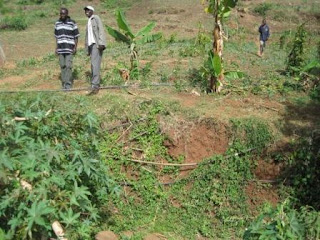Collecting a sample from a well.
The scientific side of our trip to Kenya is a research project involves a study of precipitation, surface water, and groundwater. Carey is also working on writing up papers, one of which involves (guess what?) studies of precipitation, surface water, and groundwater in Kittitas Valley. I am also working on looking at the resource use and environmental impact of Kenyans.
Our project is aimed at answering two questions: How does the chemistry of the water change as it travels through the ground? How do the changes in chemistry tell us about how the water interacts with surface water and travels through the ground?
A residential borehole with precious water about 10m below ground level.
First of all, why should we care about this? Access to adequate clean water is a basic human need. We use water not just for drinking, but for agriculture and food production. According to the World Bank, in 2007 1.1 billion people do not have access to sufficient water for basic health. The World Bank estimates that 50% of the world’s population will live “under conditions of severe water stress,” with most of these people living in Africa, the Middle East, and South Asia. Even in developed areas like Kittitas Valley, water rights are fiercely fought over. Groundwater accounts for almost one third (most of the other two-thirds is ice) of the freshwater on Earth, but because it is underground, it is difficult to study. In Washington State, the Department of Ecology has ordered studies of the impact of groundwater use on surface water. Understanding how groundwater moves is a key part of understanding this important water resource.
Another reason understanding groundwater is important is that groundwater plays a role in moving elements around the Earth in what are called biogeochemical cycles. For example, some of the elements in the ocean that make it “salty” came from chemical weathering of rocks on land by water. Understanding groundwater is important to understanding how elements move through Earth systems.
Carey recording GPS coordinates after sampling a river.
In our study we will sample precipitation, wells, streams and lakes in the Iten area. We will bring these samples back to the U.S. to analyze them for their isotopic and elemental composition. Isotopes are atoms of the same element with different numbers of neutrons. Water is H2O, but there are three different isotopes of oxygen. As water moves through the ground and interacts with soil and rocks or when different water bodies mix, the amount of these different isotopes can changes. The water also dissolves elements from the rocks and soils. By comparing the precipitation with the groundwater, we can surmise how long the water was in the ground and what types of rocks it interacted with.
For example, if the precipitation contains very little sodium and the groundwater contains a lot of sodium, the water interacted with rocks containing sodium. If the surface rocks contain very little sodium, then the water must have traveled to a deeper layer. Streams and lakes have different isotopic compositions; measuring the groundwater's isotopic composition can indicate where that water infiltrated the ground. In a way, our chemical analysis is like an “x-ray” that shows the way water moves where we can’t actually see it (it just doesn’t make a neat picture.)
So we have been scouring the countryside, looking for water. Locals have been very helpful in pointing us to springs, rivers, and lakes. We also have a precipitation collector made from a 2-liter pop bottle (I can imagine all the 9th graders remembering their precipitation projects!). Whenever it rains we collect the precipitation for analysis.
Pipes (there are about 8 here) bring water for household and irrigation. This location is on a bench about 200m down the rift valley. Next to the people are banana trees.
Water availability is a common topic of conversation here, and access to purified water is the exception rather than the rule. Many people spend a lot of time and effort carrying water from a spring to their house, or installing pipes to bring water. It will be interesting to learn more about the behavior of the natural water system that these people depend on.




Bovine thyroid is the best supplements I've tried. I quickly ramped up to 50 mg daily & continued this dose for nearly 2 months. It's a big difference and I can see it in the results of my blood tests.
ReplyDelete